Main menu
Common skin conditions

NEWS
Join DermNet PRO
Read more
Quick links
Author and DermNet Editor-in-Chief: Dr Amanda Oakley, Dermatologist, Hamilton, New Zealand, January 2015. DermNet Update April 2021
Introduction
Demographics
Causes
Clinical features
Diagnosis
Treatment
Outlook
Chronic urticaria is defined as daily itchy wealing of the skin for more than six weeks. Chronic urticaria may be spontaneous or inducible, which may co-exist.
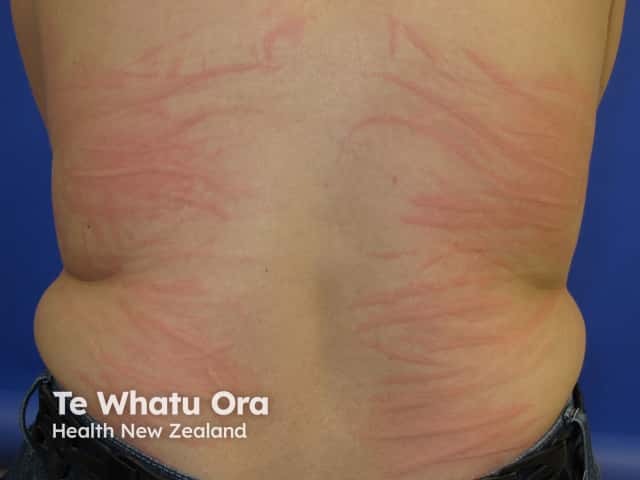
Dermographism: inducible urticaria
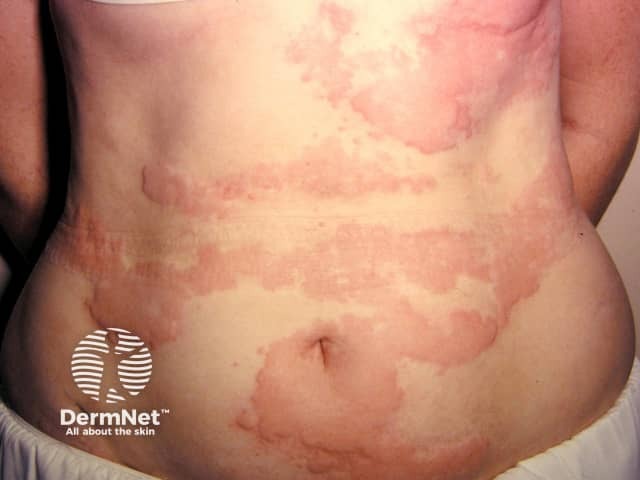
Spontaneous urticaria
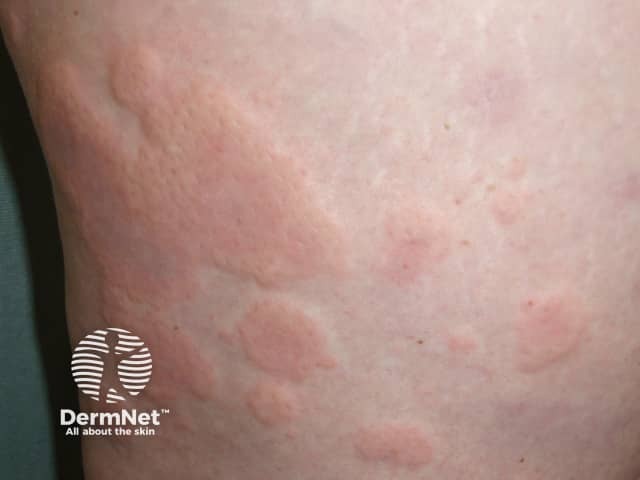
Spontaneous urticaria
Chronic urticaria can affect children and adults. Chronic inducible urticaria is more common than chronic spontaneous urticaria.
Adults with chronic urticaria have a significantly higher prevalence of atopic dermatitis, asthma, and allergic rhinitis than a control population. In children, the prevalence of atopy is similar in those with chronic urticaria as the general population.
Chronic spontaneous urticaria affects 0.5–2% of the population; in some series, two-thirds are women. There are genetic and autoimmune associations.
Weals are due to release of chemical mediators from tissue mast cells and circulating basophils. These chemical mediators include histamine, platelet-activating factor, and cytokines. The mediators activate sensory nerves and cause dilation of blood vessels and leakage of fluid into surrounding tissues. Bradykinin release causes angioedema.
Several hypotheses have been proposed to explain urticaria. The immune, arachidonic acid and coagulation systems are involved, and genetic mutations are under investigation, as are IL-4/-13 inhibitors such as dupilumab.
Chronic spontaneous urticaria is mainly idiopathic (cause unknown). An autoimmune cause is likely. About half of investigated patients carry functional IgG autoantibodies to immunoglobulin IgE or high-affinity receptor FcεRIα.
Chronic spontaneous urticaria has also been associated with:
Weals in chronic spontaneous urticaria may be aggravated by:
Chronic inducible urticaria is a response to a physical stimulus.
Recurrent angioedema without urticaria can be due to inherited or acquired complement C1 esterase deficiency, or to the longterm use of an ACE inhibitor drug. [see ACE inhibitor-induced angioedema]
Urticaria is characterised by weals.

Urticaria
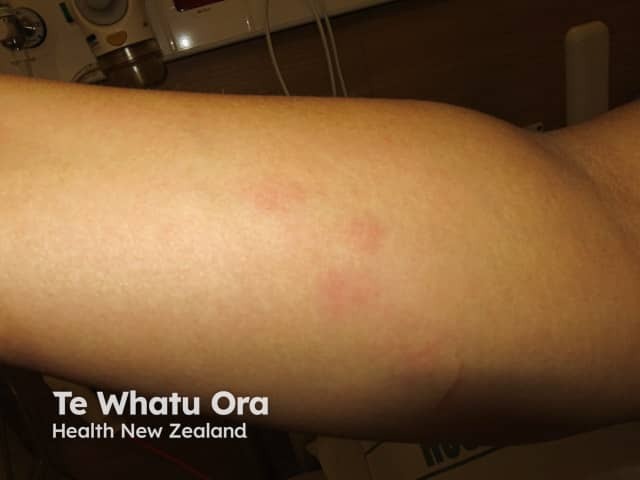
Urticaria in skin of colour
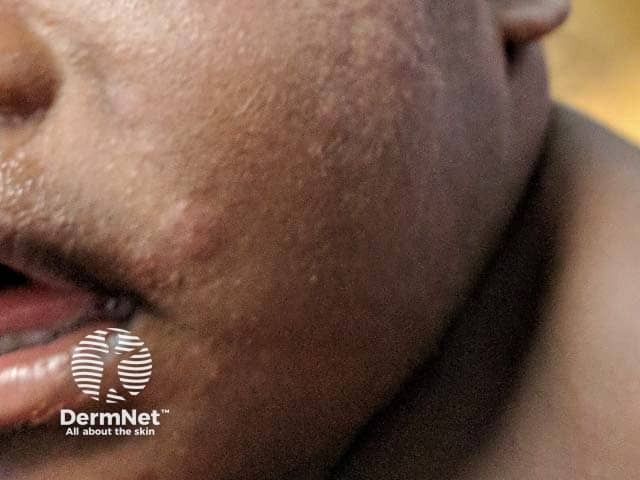
Urticarial rash in skin of colour
Angioedema is more often localised.
In chronic inducible urticaria, weals appear about 5 minutes after the stimulus and last a few minutes or up to one hour. Characteristically, weals are:
The weals are more persistent in chronic spontaneous urticaria, but each has disappeared or has altered in shape within 24 hours. They may occur at certain times of the day.
Visual analogue scales can be used to record and compare the degree of itch.
The activity of chronic urticaria can be assessed using the UAS7 scoring system. The daily weal/itch scores are added up for seven days; the maximum score is 42.
Score 0
Score 1
Score 2
Score 3
The emotional impact of urticaria and its effect on the quality of life should also be assessed. The Dermatology Life Quality Index (DLQI) and CU-Q2oL, a specific questionnaire for chronic urticaria, have been validated for chronic urticaria, where sleep disruption is a particular problem.
Some patients with chronic spontaneous urticaria report associated systemic symptoms. These include:
Chronic urticaria is diagnosed in people with a long history of daily or episodic weals that last less than 24 hours, with or without angioedema. A medication and family history should be elicited. A thorough physical examination should be undertaken to evaluate the cause.
Inducible urticaria is often confirmed by inducing the reaction, such as scratching the skin in dermographism or applying an ice cube in suspected cold urticaria.
Suggested investigations for chronic spontaneous urticaria:
Further investigations should only be undertaken if an underlying disorder is suspected on history and examination.
The main treatment for chronic urticaria in adults and children is with an oral second-generation H1-antihistamines such as cetirizine or loratidine. If the standard dose (eg, 10 mg for cetirizine) is not effective, the dose can be increased fourfold (eg, 40 mg cetirizine daily). The addition of a second antihistamine is not thought to be helpful.
Terfenadine and astemizole should not be used as they are cardiotoxic in combination with ketoconazole or erythromycin. They are no longer available in New Zealand.
Although systemic treatment is best avoided during pregnancy and breastfeeding, there have been no reports that second-generation antihistamines cause birth defects. If treatment is required, loratadine and cetirizine are currently preferred.
Conventional first-generation antihistamines such as promethazine or chlorpheniramine are no longer recommended for chronic urticaria.
Identifiable triggers for urticaria should be avoided where possible. For example:
The physical triggers for inducible urticaria should be minimised; see examples below. However, symptoms often persist.
Some patients with inducible urticaria benefit from daily induction of symptoms to induce tolerance. Phototherapy may be helpful for symptomatic dermographism.
Patients with chronic urticaria that has failed to respond to maximum-dose second-generation oral antihistamines taken for four weeks should be referred to a dermatologist, immunologist, or medical allergy specialist.
Omalizumab is now regarded as the treatment of choice for antihistamine-resistant patients. Ciclosporin is a fourth-line option. Remibrutinib and fenebrutinib, promising novel BTK inhibitors, are currently under investigation, as are IL-4/-13 inhibitors such as dupilumab.
Long-term systemic corticosteroids are not generally recommended, as high doses are often required to control symptoms of urticaria and they have inevitable adverse effects that can be serious. However, a study published in 2017 reported effective clearance and a long-lasting response of autoimmune chronic urticaria to low-dose oral prednisolone for several months.
The natural history of chronic spontaneous urticaria in children and adults is the same, with the chance of remission within three years being 30-50% and after five years 40-70%.
Chronic inducible urticaria seems to be more persistent, particularly cold urticaria and solar urticaria.